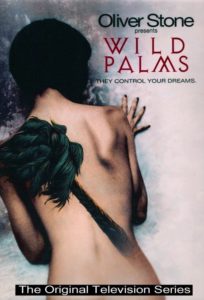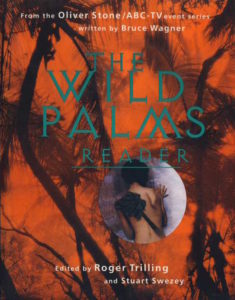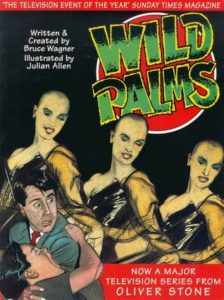 Right now, with nineties nostalgia in full swing, I think it’s a good time to look back at WILD PALMS. A six episode ABC miniseries that aired in May-June of 1993, WILD PALMS was a quintessential nineties product, being a heavily promoted “event” that was never as weird or revolutionary as the “psychedelic dossier filled with borrowed moonlight from a floating world” it purported to be.
Right now, with nineties nostalgia in full swing, I think it’s a good time to look back at WILD PALMS. A six episode ABC miniseries that aired in May-June of 1993, WILD PALMS was a quintessential nineties product, being a heavily promoted “event” that was never as weird or revolutionary as the “psychedelic dossier filled with borrowed moonlight from a floating world” it purported to be.
Inspired by a serialized comic (more on that below), WILD PALMS’ true progenitor was TWIN PEAKS, which ABC had premiered three years earlier, and consistently evoked in the publicity for WILD PALMS. Never mind that TWIN PEAKS had only lasted two seasons, and suffered a rather severe backlash (and that PEAKS’S creator David Lynch was clearly none too happy about WILD PALMS, as evinced by a pissy retort Lynch gave an interviewer: “People said WILD PALMS had something to do with TWIN PEAKS. To me it had zip to do with TWIN PEAKS. ZZZIP!”).
Furthering the nineties vibe was the presence of Oliver Stone as executive producer. Stone, coming off JFK and gearing up for NATURAL BORN KILLERS, was a ubiquitous media presence at the time, and write-ups of WILD PALMS focused disproportionally on his involvement. In a 1993 interview WILD PALMS co-star Angie Dickinson gushes at some length about meeting Mr. Stone but doesn’t mention the show’s writer, creator and co-executive producer Bruce Wagner at all, even though Wagner’s was clearly the guiding vision.
Anyone who’s read (or in my case, tried to read) Wagner’s novels FORCE MAJEURE and I’M LOSING YOU, or seen the Wagner scripted flick MAPS TO THE STARS, will recognize WILD PALMS’S Hollywood milieu and flamboyant pop culture inflected dialogue (examples: “He had one foot in the rave,” “There are no politics anymore, just fathers and beach houses”).
In WILD PALMS Wagner’s showbiz predilections are manifested in the figure of Harry Wyckoff (Jim Belushi), a Beverly Hills attorney contracted by an old flame (Kim Cattrall) to track down her missing son. From there Harry is inducted into an insanely wide-ranging jumble of politics, conspiracies and twisted family ties. It all centers on the titular organization, a freaky high tech cult run by the power-mad senator Anton Kreutzer (Robert Loggia), who’s looking to take over the world through a high tech virtual reality program. Along the way Harry learns the child he calls his son may not actually be his, and that his mother-in-law Josie (Angie Dickinson) is intimately involved in the doings of Wild Palms and its leader.
That’s a distillation of Wagner’s script, which involves at least a dozen pivotal characters and just as many subplots. A phone number (1-900-773-WILD) was set up to help explain the plot to viewers, but I honestly don’t believe anyone will be able to fully decipher the thing (Johnny Carson to the attendees of a 1993 awards luncheon: “I’d be very grateful if just one person in this room could tell me what WILD PALMS was all about”). It’s all the more disappointing, then, that the overall story arc is so routine, with Harry joining an anti-Wild Palms resistance movement, and ultimately overthrowing Kreutzer.
WILD PALMS’S directors were a virtual who’s-who of hot young nineties filmmakers: Peter Hewitt, Phil Joanou, Keith Gordon and Katherine Bigelow. None of them, unfortunately, were able to do much with the program, which despite its “futuristic” setting (the far-off year 2007!) is afflicted with tacky early-1990s video resolution, and summons barely a hint of the exquisite strangeness of TWIN PEAKS. Wagner and his collaborators, it seems, confused surrealism with over-complexity.
The one really striking element is the new agey score by Ryuichi Sakamoto, but even that hasn’t dated well, having been accomplished via very 1980s sounding synthesizers. As for the show’s most memorable scene, it involves Harry meeting NEUROMANCER author William Gibson, who Harry credits with coining the term cyberspace—Gibson’s much quoted response: “And they won’t let me forget it!”
Being the “event” program it was, WILD PALMS inspired some notably elaborate promotional material, including a gaudy trade paperback tie-in that’s  become more famous than the show itself. The reason? The book, co-edited by Stuart Sweezey of the underground publishing outfit Amok, contains original fiction by a number of science fiction legends (William Gibson, Thomas M. Disch, Bruce Sterling, Pat Cadigan, Norman Spinrad) and assorted underground figures (cartoonist Spain Rodriguez, Throbbing Gristle co-founder Genesis P. Orridge, Sex Pistols manager Malcolm McLaren, ero-guro artist Suehiro Maruo). It would be nice to report that the book is the subversive triumph it was cracked up to be, but, frankly, it isn’t.
become more famous than the show itself. The reason? The book, co-edited by Stuart Sweezey of the underground publishing outfit Amok, contains original fiction by a number of science fiction legends (William Gibson, Thomas M. Disch, Bruce Sterling, Pat Cadigan, Norman Spinrad) and assorted underground figures (cartoonist Spain Rodriguez, Throbbing Gristle co-founder Genesis P. Orridge, Sex Pistols manager Malcolm McLaren, ero-guro artist Suehiro Maruo). It would be nice to report that the book is the subversive triumph it was cracked up to be, but, frankly, it isn’t.
The WILD PALMS READER looks good, certainly, with an agreeably kaleidoscopic design that freely incorporates artistic collages, stills from the series, stock photos, pages from Wagner’s script and panels from the comic serial that inspired the series. That, however, doesn’t make up for the fact that the book is never very compelling. Full, or even partial, comprehension is impossible without a thorough knowledge of the series, but even then the contents leave something to be desired.
For starters, the stories are too short, with each running but a page or two. Thus none of the authors are ever given a chance to really shine, especially with the eye-burning visual design, which has the effect of drowning out the texts. Nor are most of those texts, which tend to focus on Anton Kreutzer’s political campaigns and the marketing of his virtual reality products, especially invigorating.
In fairness, there is one genuinely interesting piece: “Floating World—Los Angeles: 1993-2008” by Ralph Rugoff and Fred Dewey, an imagined history of LA in the nineties and early 00s, wherein a Rodney King mega-mall is constructed, the Crips and Bloods street gangs are signed by CAA, gasoline driven vehicles are banned and virtual reality all-but takes over. It’s the book’s most imaginative contribution, and the only portion that can be enjoyed independently of the series.
Of course, there was a second WILD PALMS tie-in book released in ‘93, though in far more limited form than THE WILD PALMS READER. The WILD PALMS graphic novel, published by the UK based Arrow Books, was a collection of the Bruce Wagner scripted WILD PALMS comic strips originally published in Details magazine from 1990-93. The book has gone on to become a rare and expensive collector’s item, and with good reason: it is the material’s foremost incarnation by far, displaying all the mind-blown oddness the series tried for but failed to achieve.
 The book’s origins as a serialized comic strip are evident in the fact that a “Wild Palms” logo appears at the beginning of every couple pages, and also the frequent “To Be Continued…” sign-offs. Yet the narrative related in these pages (which includes an early incarnation of MAPS TO THE STARS) is quite streamlined, at once simpler and more complex than that of the miniseries. It’s also appreciably stranger, with a trippy VIDEODROME-ish arc decreeing that much of what the protagonist experiences is in fact a vast hallucination.
The book’s origins as a serialized comic strip are evident in the fact that a “Wild Palms” logo appears at the beginning of every couple pages, and also the frequent “To Be Continued…” sign-offs. Yet the narrative related in these pages (which includes an early incarnation of MAPS TO THE STARS) is quite streamlined, at once simpler and more complex than that of the miniseries. It’s also appreciably stranger, with a trippy VIDEODROME-ish arc decreeing that much of what the protagonist experiences is in fact a vast hallucination.
Wagner’s show business obsession is pivotal here, with Harry Wyckoff’s glitzy Hollywood surroundings literally overtaking his reality. Particularly striking is the use of real world celebrities, who (unlike the miniseries, which confined itself to a handful of famous person cameos) become participants in the drama. Carrie Fisher is an important player, as are Don Simpson, Ray Bradbury and the series’ stars Jim Belushi and Dana Delany, who actually appear in stills from the series that are incorporated into the comic’s final pages (which, of course, were completed around the time the program was being filmed), thus initiating an intriguing comic-series crossover. The gorgeous photo-realistic artwork of Julian Allen is pivotal to the effect, integrating actual celebrity headshots into its tapestry in a manner that, in a potent demonstration of the power of counterpointing, actually enhances the hallucinatory nature of the enterprise.
So yes: WILD PALMS did start out on the right foot, but lost its way at some point during the transposition from comic strip to miniseries. At least one great publication emerged from the rubble, even if that publication is very hard to find.
